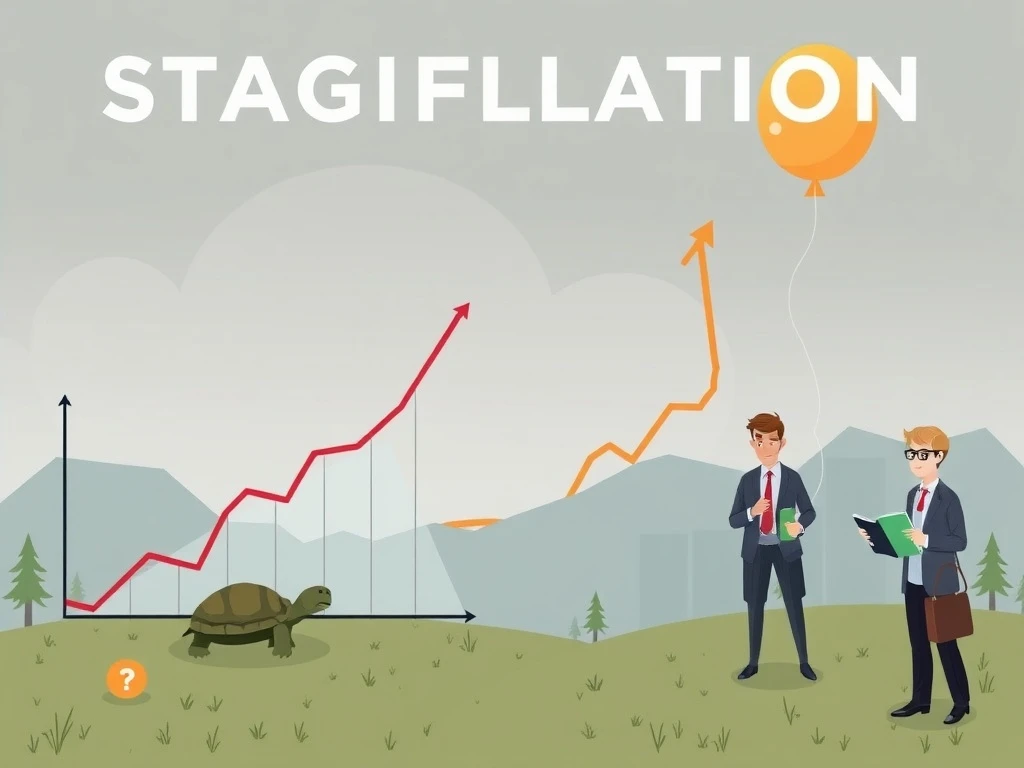Investors today face a complex economic landscape. Many financial experts now discuss a significant challenge: **stagflation**. This term describes a difficult economic condition. It combines slow economic growth with high inflation and high unemployment. Historically, this scenario has proven particularly challenging for investors. Understanding this potential threat is crucial for effective portfolio management. Therefore, prudent investors must analyze current market signals carefully. They need to prepare for various economic outcomes. Ignoring the possibility of **stagflation** could lead to significant financial setbacks. Consequently, a proactive approach becomes essential for all market participants.
Understanding the Stagflation Threat to Portfolios
What exactly is **stagflation**? It is a portmanteau of “stagnation” and “inflation.” Economists define it by three key characteristics. First, there is a period of sluggish or negative economic growth. This means a slowdown in gross domestic product (GDP). Second, the economy experiences persistent high inflation. Prices for goods and services rise significantly. Third, unemployment rates remain elevated. This combination creates a difficult environment. Consumers face higher costs but have less purchasing power. Businesses struggle with reduced demand and rising input costs. Historically, this economic phenomenon poses unique challenges for policymakers. They find it difficult to combat inflation without worsening unemployment or vice versa. Therefore, understanding its core components is vital for investors.
Historical Parallels and Current Concerns Regarding Stagflation
The 1970s offer a clear historical example of **stagflation**. During that decade, the global economy faced several shocks. These included oil price increases and expansionary monetary policies. Consequently, many developed nations experienced both high inflation and economic stagnation. This period saw significant market volatility. Stock markets performed poorly. Bond yields struggled to keep pace with inflation. Today, some economic indicators suggest similar pressures. Supply chain disruptions persist globally. Energy prices remain volatile. Furthermore, significant government spending and accommodative monetary policies have injected liquidity into systems. These factors contribute to inflationary pressures. At the same time, growth forecasts show signs of slowing. Geopolitical tensions also add to economic uncertainty. Therefore, many analysts express concerns about a potential return of **stagflation**-like conditions. Investors must consider these historical lessons. They should evaluate current economic signals cautiously.
How Stagflation Impacts Investment Portfolios
A **stagflation** environment profoundly affects various asset classes. Each investment type reacts differently to this unique economic cocktail. Understanding these impacts helps investors adjust their strategies. For instance, equities often suffer. Corporate earnings decline due to slower growth and higher input costs. Consumer spending also weakens. This double blow reduces company profitability. High inflation erodes the real value of future earnings. Consequently, stock valuations can fall significantly. Growth stocks, particularly, may underperform. They rely heavily on future earnings potential. Value stocks or those in defensive sectors might offer more resilience. Investors should review their equity holdings. They need to identify vulnerable sectors. This proactive step helps mitigate potential losses.
Navigating Market Volatility with Stagflation in Mind
Fixed-income investments, like bonds, also face headwinds during **stagflation**. Inflation erodes the purchasing power of fixed interest payments. Rising interest rates, often used to combat inflation, reduce bond prices. Long-duration bonds are especially vulnerable. Their sensitivity to interest rate changes is higher. Therefore, their market value can drop sharply. Investors holding traditional bond portfolios might see negative real returns. Short-duration bonds or inflation-protected securities (TIPS) may offer better protection. However, even these instruments carry risks. Real estate markets also experience challenges. Higher interest rates increase borrowing costs. This can cool housing demand. Property values might stagnate or decline. Rental income may not keep pace with rising operational costs. Overall, **stagflation** creates a challenging climate for most conventional investment vehicles.
Strategic Approaches for Investors Facing Stagflation
Despite the challenges, investors can adopt strategies to navigate **stagflation**. Diversification remains a cornerstone of prudent investing. It spreads risk across different asset classes. This approach helps cushion portfolio shocks. Certain assets tend to perform better during inflationary periods. Commodities, for example, often act as inflation hedges. Gold, silver, and other precious metals historically retain value. They may even appreciate when fiat currencies lose purchasing power. Energy and agricultural commodities also tend to rise with inflation. Investing in commodity-linked exchange-traded funds (ETFs) or direct futures can provide exposure. However, commodity markets are volatile. Therefore, careful consideration and risk management are necessary. Furthermore, investors should evaluate their exposure to inflation-sensitive sectors. These sectors often include utilities, consumer staples, and healthcare. They may offer more stable earnings during economic downturns.
Identifying Key Indicators of Worsening Stagflation
Actively monitoring key economic indicators is crucial for investors. These indicators provide insights into the evolving economic landscape. The Consumer Price Index (CPI) measures inflation. A consistently high CPI signals ongoing price pressures. Gross Domestic Product (GDP) reports indicate economic growth. A declining or negative GDP growth rate points to stagnation. Unemployment rates also offer vital clues. Rising unemployment alongside high inflation strongly suggests **stagflation**. Central bank policies, especially interest rate decisions, are also important. Aggressive rate hikes might curb inflation but could also slow growth further. Conversely, reluctance to raise rates might allow inflation to persist. Observing these metrics helps investors anticipate shifts. They can then adjust their portfolios accordingly. Furthermore, global supply chain health and geopolitical developments influence these indicators. Remaining informed about these broader trends is paramount.
Ultimately, the threat of **stagflation** demands attention from every investor. While not guaranteed, the confluence of current economic factors warrants preparedness. A thoughtful investment strategy can mitigate risks. It can also identify potential opportunities. Focus on assets that historically perform well in such environments. Diversify your portfolio broadly. Maintain a long-term perspective. Regular portfolio reviews are also essential. They ensure your investments align with changing economic realities. By understanding **stagflation** and its implications, investors can make informed decisions. This proactive stance helps protect and grow wealth, even during uncertain times.
Frequently Asked Questions (FAQs) About Stagflation
What is stagflation?
Stagflation describes an economic condition characterized by slow economic growth, high unemployment, and rising prices (inflation). It is a challenging scenario for policymakers because measures to combat one issue often worsen another.
Why is stagflation considered a significant threat to investors?
Stagflation erodes investment returns across many asset classes. High inflation diminishes the real value of earnings and fixed-income payments, while slow growth negatively impacts corporate profits and stock valuations. This combination makes it difficult for traditional portfolios to generate positive real returns.
What assets might perform well during stagflation?
Historically, certain assets have shown resilience during stagflation. These include commodities (like gold, silver, and energy), inflation-protected securities (TIPS), and stocks of companies in defensive sectors (e.g., utilities, consumer staples, healthcare) that can pass on rising costs to consumers.
How can investors prepare their portfolios for potential stagflation?
Investors can prepare by diversifying their portfolios across various asset classes, considering inflation-hedging assets like commodities, focusing on value stocks or dividend-paying companies, and potentially reducing exposure to long-duration bonds. Regular portfolio reviews and staying informed about economic indicators are also crucial.
Did stagflation happen before?
Yes, the most notable period of stagflation occurred in the 1970s, particularly in the United States and other developed nations. This era was marked by oil shocks, high inflation, and economic slowdowns, offering valuable lessons for today’s economic environment.
























